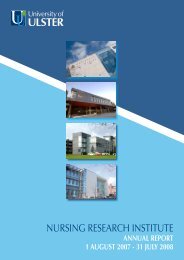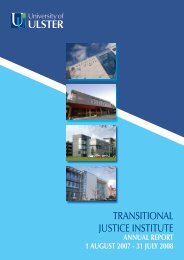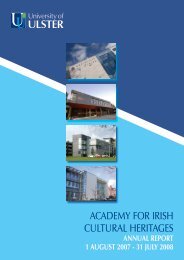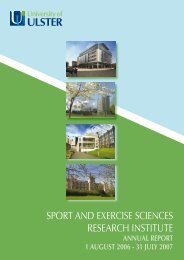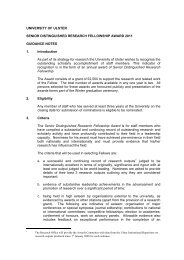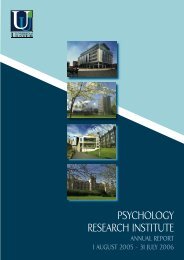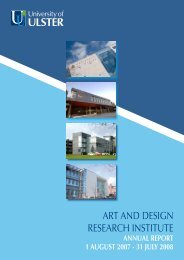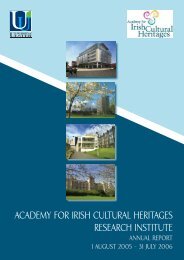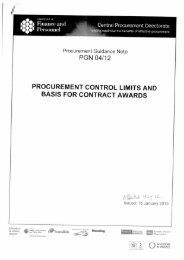environmental sciences research institute - University of Ulster
environmental sciences research institute - University of Ulster
environmental sciences research institute - University of Ulster
You also want an ePaper? Increase the reach of your titles
YUMPU automatically turns print PDFs into web optimized ePapers that Google loves.
4.3 FRESHWATER SCIENCE<br />
Toxic metals in the aquatic food chain<br />
Figure 1. The pristine environment <strong>of</strong> Loch Coire nan Arr in the<br />
north Scottish Highlands (one <strong>of</strong> the study lakes) where the<br />
aquatic life are subject to toxic metal burden.<br />
The growth <strong>of</strong> the global economy since the early 20th<br />
Century has been mirrored by atmospheric trace metal<br />
burden. Consequently, toxic metals such as lead (Pb),<br />
cadmium (Cd) and mercury (Hg) have entered freshwater<br />
lakes. This has posed a threat to ecosystems and humans<br />
as these metals are accumulated by the primary producers<br />
(the<br />
phytoplankton) and subsequently transferred through<br />
the aquatic food chain. Therefore the United Nations<br />
Economic Commission for Europe adopted the Heavy<br />
Metals Protocol to encourage modelling, <strong>research</strong> and descriptions <strong>of</strong> metal pathways. However, accurate modelling <strong>of</strong><br />
these pathways in freshwater lakes has been inhibited by a lack <strong>of</strong> knowledge on metal uptake by the phytoplankton. This<br />
is particularly due to the temporal and spatial variations in phytoplankton biomass that stems from their photosynthetic<br />
nature and variations in their growth limiting nutrient, phosphorus.<br />
This project has focused on quantifying the short-term changes in the uptake <strong>of</strong> Pb, Cd and Hg by the phytoplankton in<br />
lakes <strong>of</strong> varying nutrient status. Three remote Scottish lakes that have received high, medium or low metal contamination<br />
from the atmosphere were selected for analysis. Phytoplankton specimens were collected and the behaviour <strong>of</strong> metals in<br />
the sediment was investigated with continuous sediment traps and sediment cores. The technique <strong>of</strong> diffusive gradients<br />
in thin film was employed to assess the distribution <strong>of</strong> dissolved metals. Concentrations <strong>of</strong> Pb, Cd and Hg in the<br />
phytoplankton and sediment were analysed with Inductively Coupled Plasma-Mass Spectrometry.<br />
A redox sensitive release <strong>of</strong> metals from the sediment was found during the early spring as dissolved oxygen in the lakes<br />
declined due to higher community respiration rates. The concentration <strong>of</strong> metals then accumulated by the phytoplankton<br />
varied between the taxonomic groups and their metabolic demand or sensitivity <strong>of</strong> each metal. Furthermore, the<br />
phytoplankton were more concentrated with Pb, Cd and Hg in poor nutrient status waters that receive low metal<br />
contamination from the atmosphere than in nutrient rich (eutrophic) waters receiving high metal contamination.<br />
Considering the possibility <strong>of</strong> these metals transferring through the aquatic food chain, the ecosystems in nutrient poor<br />
waters may be under a greater threat <strong>of</strong> toxicity.<br />
DEL Funded PhD Studentship, Supervisor: Dr Richard Douglas, Student: Áine Gormley<br />
References.<br />
Gormley, A. M., The Impact <strong>of</strong> Algae Growth on the Transport <strong>of</strong> Toxic Metals in Lakes, in Proceedings <strong>of</strong> the Thermo<br />
Scientific ICP-MS Users Meeting, The UK National Space Centre, England, 2007<br />
Gormley, A. M., The Impact <strong>of</strong> Phytoplankton Growth on the Biogeochemical Cycling <strong>of</strong> Metals in Lakes, in Proceedings<br />
<strong>of</strong> the 30th Congress <strong>of</strong> the International Association <strong>of</strong> Theoretical and Applied Limnology in Montreal, Canada, 2007<br />
<br />
13



